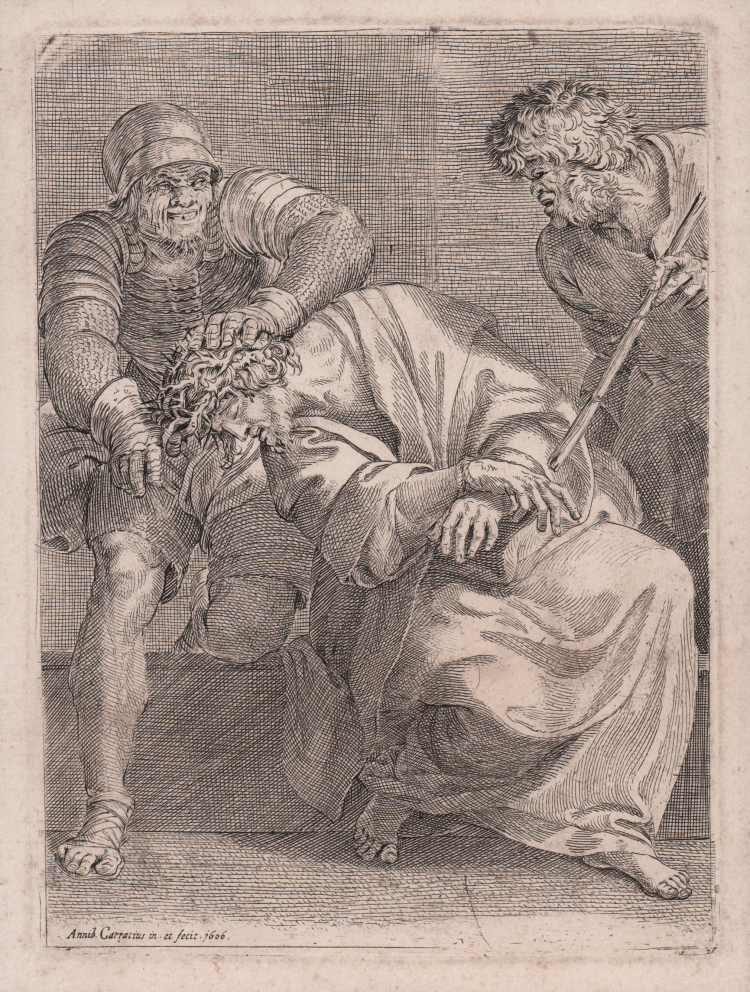




| Reference: | S47065 |
| Author | Annibale CARRACCI |
| Year: | 1606 |
| Measures: | 132 x 180 mm |



| Reference: | S47065 |
| Author | Annibale CARRACCI |
| Year: | 1606 |
| Measures: | 132 x 180 mm |
Christ crowned with thorns; Christ, with bound hands and wearing a crown of thorns, seated on a low block between two soldiers, one standing to right and poking him with a reed, the other standing kneeling on the block and pushing Christ's head down.
Etching, 1606, dated and lettered within image with production detail: "Annib. Carracius in. et fecit".
“This small devotional work was done at the time when Annibale had largely had to give up painting because of the breakdown that he suffered around 1605. In the same year of 1606 he dated another etching, the Madonna della Scodella, also a small devotional piece in which all subsidiary elements are omitted to allow complete concentration on the figures, their actions and emotions. The emotional intensity of the Crowning is remarkable: Christ is caught between the sadistic violence of the armoured figure and the contemptuous stare of the animal-like man with the reed. There are several impressions known of a state without letters, suggesting that initially it could have circulated privately. However the addition of letters coincides with an intensification of the shadows and Annibale himself must have prepared it for a more public role. Annibale may have taken up etching again because he was unable to undertake larger, public projects. He will have needed to earn money and this plate along with others must have been sold. In the inventory of Annibale's possessions, drawn up 17 July 1609, there is no trace of any plates. Recently Maccherini has published a document showing that four small etched plates by Annibale belonged to Giovanni Orlandi before 20 November 1609 ('Prospettiva' 86,1997, p. 83). The four etched plates mentioned are likely to have been the four that Annibale is known to have executed in Rome. They are the present one, the Christ of Caprarola (1597; Bohlin 18), the Madonna della Scodella (1606; Bohlin 20) and the undated Adoration of the Shepherds (Bohlin 22). They were all acquired by Nicolas van Aelst before his death in 1613, for they carry his address in late states. Nicolas frequently bought used plates from other print dealers. A drawing at Chatsworth which is indented with a stylus for transfer (Jaffé no.486) was probably the model that Annibale used to transfer the design to the plate. However changes were made to the exact positions of the figures, and also in the iconography, between drawing and etching. Pentimenti on the plate itself bear witness to this process, especially visible where the right forearm of the man with the reed has been adjusted to a lower position. In the drawing he was pulling tight a cord around Christ's wrists” (cf. Michael Bury, 'The Print in Italy 1550-1620', BM 2001, cat.50.)
Good example, printed on laid paper datable to the first half of the 17th century, with thin margins, in very good condition.
Bibliografia
Bartsch, Le Peintre graveur (XVIII.182.3); Bohlin 1979, Prints and related drawings by the Carracci family (21.II); Posner 1971, Annibale Carracci, a study in the reform of Italian painting around 1590 (174); Michael Bury, 'The Print in Italy 1550-1620', BM 2001, cat. 50.
Annibale CARRACCI (Bologna 1560 - Roma 1609)
|
Younger brother of Agostino and cousin of Ludovico, who was also his teacher, Annibale is the leading figure of the XVII century school of Bologna and among the greatest artist of Italian Classicism.
The initial stage of his art was still very close to late Mannerism, tightly connected with Campi’s style. He then came to maturity, under an artistic point of view, drawing inspiration from the greatest artists of Italian Renaissance and he expressed the climax of his career in the frescoes inside Palazzo Farnese (1595-1604) in Rome, which are considered the highest example of Italian Classicism.
Following Agostino, he started to study engraving and etching; we can ascribe to him 17 prints, mainly with religious subjects. Just two of them bear a mythological subject in which it can be found once again the Alexandrine spirit of the mythological tale.
|
Annibale CARRACCI (Bologna 1560 - Roma 1609)
|
Younger brother of Agostino and cousin of Ludovico, who was also his teacher, Annibale is the leading figure of the XVII century school of Bologna and among the greatest artist of Italian Classicism.
The initial stage of his art was still very close to late Mannerism, tightly connected with Campi’s style. He then came to maturity, under an artistic point of view, drawing inspiration from the greatest artists of Italian Renaissance and he expressed the climax of his career in the frescoes inside Palazzo Farnese (1595-1604) in Rome, which are considered the highest example of Italian Classicism.
Following Agostino, he started to study engraving and etching; we can ascribe to him 17 prints, mainly with religious subjects. Just two of them bear a mythological subject in which it can be found once again the Alexandrine spirit of the mythological tale.
|